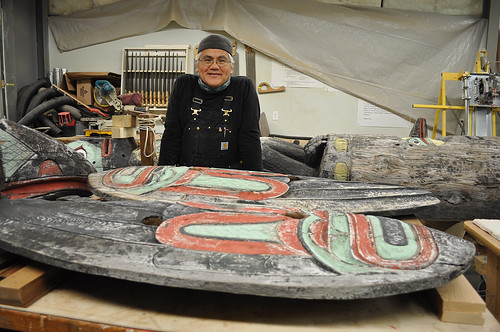
In a small U.S. Forest Service workshop in Juneau, Alaska, a skilled Alaska Native artist is meticulously bringing a traditional artifact back to life. Tlingit Master Carver Wayne Price of Haines has begun the process of restoring the totem, which has overlooked the Auke Recreation Area near Juneau for more than 70 years.
In 1941, Frank St. Clair, a Tlingit from Hoonah, and two members of the Civilian Conservation Corps, originally carved the Yax té or Big Dipper totem, which symbolizes a “place where a strong tribe flourished.” The Aak’w Kwáan, according to historical documents, were Tlingit people and among the first to settle in the Juneau area.
“I am glad to see this pole being restored and happy to hear that it will stand again at the Auke Village site where it was originally erected,” said Myra Gilliam, a Forest Service archaeologist for Admiralty National Monument, Juneau and Yakutat Ranger Districts.
Linn Forrest, a Forest Service landscape architect, designed the totem in the early 1940’s and it was the initial pole of his vision for a “Totem Park” in Juneau. However, his dream for an Auke Village “Totem Park” was never realized because World War II started and affected funding for the CCC program. Forrest also oversaw earlier totem pole restoration work at the Sitka National Historical Park in 1939 and helped design the Mendenhall Glacier Visitor Center.

Over the years, heavy rains and insects began affecting the structural integrity of the Yax té totem, which was originally planted directly in the soil. The totem suffered the effects of stubborn woodpeckers and was also damaged by arsonists. A few years ago, the Forest Service took down the totem in the interest of public safety and placed it in storage.
Over the years, the agency consulted with Aak’w Kwáan elders and the Douglas Indian Association to find a way to refurbish and re-erect the historical totem pole. Recently, the Juneau Ranger District received the necessary funding to proceed with the restoration project.
“I am grateful for the good advice of many folks who are so knowledgeable about totem pole restoration, including the master carvers who assessed the damage and are undertaking the restoration and the culturally-affiliated folks who are passionate about this totem pole and its significance,” said Gilliam. “The curators at the Alaska State Museum and the Juneau Douglas City Museum provided helpful advice and fielded many questions as did Ron Sheetz with the National Park Service Division of Conservation.”
Price began his restoration work on the totem pole March 4. The pole features six carved bird faces and is topped by a raven and supported at the bottom by the motif of a Tlingit noble woman. As he began the restoration, opening the Raven’s beak to remove rotted material, he was surprised to find a time capsule. Turns out it contained a letter from Arnold Dalton, who had restored the pole in the early 1990s after arson damage and his hopes for the totem, a commemorative coin from 1993 and several newspaper clippings about the restoration.
Arnold Dalton, who restored the pole after it suffered from arson in the early 1990s, had left a time capsule inside Raven’s beak.
Price has been creating and restoring totems for 43 years. He’s committed to ensuring the preservation of Tlingit art, culture, and traditions.
According to his Silver Cloud Art Center website, Price has carved 27 traditional totem poles, several non-traditional poles and eight traditional dugout canoes. In 2013, he designed and carved two 10-foot house posts for the Forest Service’s Forestry Sciences Laboratory in Juneau, to tell the story of the traditional land users—the Aak’w Kwáan. He has accomplished numerous other projects for museums, art institutes, parks and schools, and often presents programs and instruction on traditional Native art.
“It is a great honor to work on this totem from the 1940’s that has stood guard for so long,” said Price. “It is a wonderful project and I look forward to see it stand up again.”


